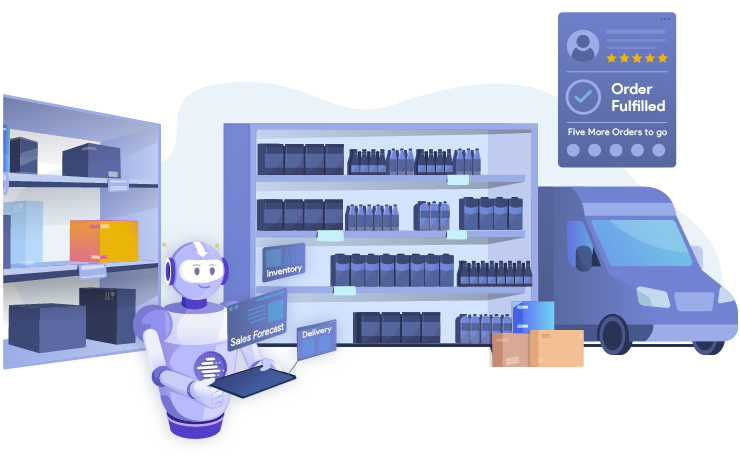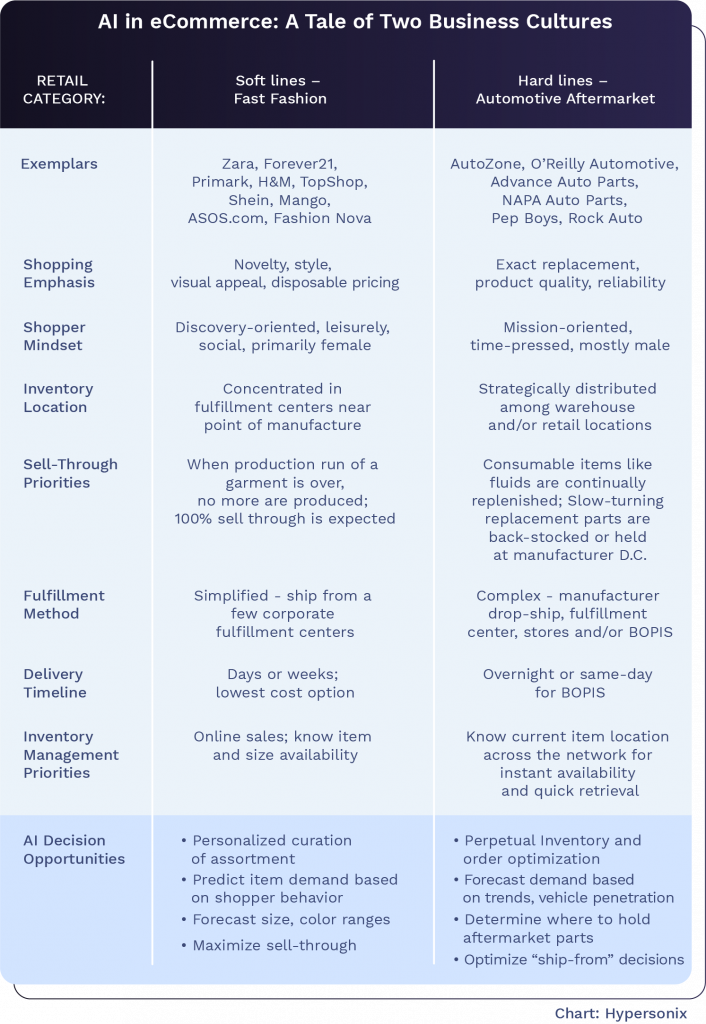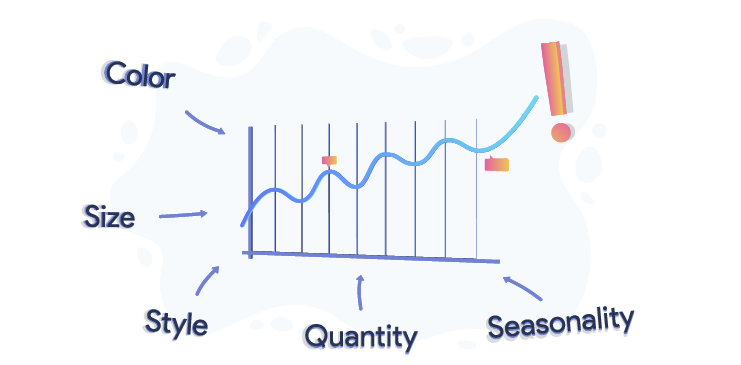AI in eCommerce: Two Perspectives
AI in eCommerce: Two Perspectives
When it comes to applying AI in eCommerce, it’s all retail. But all retail is not the same.
Quite often we see discussions of eCommerce that examine online retailers from a common perspective. At a high level, they certainly have many functions in common – web and mobile interfaces, digital merchandising, product catalog, cart and transaction functionality, fulfillment – to name a few.
There are profound differences too. Applications for artificial intelligence depend upon the unique requirements of each channel, their product categories, and the steps they take to satisfy customer expectations and ensure profits.
Each of these activities carries its own set of critical business questions and decisions, spanning merchandising, inventory management, pricing, fulfillment, customer experience, and back-end operations.

Here’s where artificial intelligence tools can make a difference, by enabling each type of enterprise to make relevant decisions faster and with greater responsiveness to changing business conditions.
To examine these distinctions further, we compare two categories of eCommerce sites that could not be more different with respect to the goods they sell, the markets they serve, and the shopping experiences they create – automotive aftermarket and fast fashion.
AI in eCommerce from two perspectives
We focused on these two channels because the contrasts between them is quite sharp: Hard lines versus soft lines. Emphasis on rapid availability versus lowest-cost pricing. Utilitarian shopping mission versus one emphasizing style and discovery.
Auto parts retailers are exemplified by AutoZone, NAPA Auto Parts, O’Reilly Automotive, and pure online sellers like Rock Auto. Their eCommerce sites emphasize search functionality that enables customers to confirm the correct parts and products for their individual vehicles before ordering. Inventory management strategies make item availability a high priority, especially for replacement parts, which must be an exact match to the vehicle being maintained. Turn rates on those items can be very slow, however.
In the fast fashion world, Zara, Forever 21, Shein, H&M are high-flyers, known for their ability to bring low-cost, on-trend garments to a mostly younger clientele. They emphasize discovery and visual appeal, offering styles that are available until sold through, to create a sense of excitement for shoppers. Distribution and inventory are generally concentrated within a few fulfillment centers, and delivery emphasizes low cost over speed.
Both retail categories face significant competition from Amazon.com and Walmart.com which set challenging standards for site functionality, assortment and inventory management, and order fulfillment, including BOPIS (buy online pickup in-store) and within-hours delivery.

Decisions, decisions
Managers at eCommerce companies confront a continuous sequence of decisions around each pillar of their businesses. All require an ability to anticipate and respond to changing business conditions. Three key decision-making areas stand out for this discussion:
- Assortment – What constitutes sufficient variety to cover the requirements of our shopper base? When is adding more a diminishing return?
- Inventory – How many units to keep in stock? How many do I have in stock? Where are they located? When to replenish and for how long? From where should an order ship?
- Digital merchandising – How should personalized assortments be curated for shoppers online and even more importantly, on the smaller real estate of the mobile screen?
Fast Fashion
Business forecasting is a perennial challenge for retailers of all sorts. Fashion and other soft-line retailers traditionally have applied experience and rules of thumb to plan seasonal product assortments with lead times as long as 12 to 18 months. The mix of quantity, color, style, and size is an educated guess. Under-buying results in stock outs and missed sales. Over-buying results in markdowns and margin loss.

Fast fashion retailers try to reduce these forecasting risks by adopting a “quick-response” approach with much shorter lead times and a shortened production period. The forecasting discipline is heavily data-driven. Combined with low retail prices they achieve a higher sell-through rate as compared with traditional apparel retailers, which enables less complex inventory management and greater free cash flow.
A great many shopping encounters on fast fashion sites are conducted via mobile devices, and smaller screens make browsing among many options difficult. AI-driven personalized merchandising, using automated curation, helps put items of interest front and center for individual shoppers, based on what is known about them and similar shoppers from past behaviors, including color and size preferences. This type of tailored experience is prime territory for artificial intelligence.
Auto Aftermarket
In the automotive retail sector shopping trips fall into several primary types: maintenance, repair, accessories, restoration, customization. Each has its own selling rhythm requiring a separate set of merchandising and inventory decisions.
- Fluids, filters, belts, and plugs are replaced regularly by weekend mechanics and must be available on-demand from store locations or BOPIS.
- Replacement parts, like gaskets, alternators, and fuel pumps, may be replaced just once during a vehicle’s lifetime and are generally slower turning. Precise compatibility is essential.
- Custom parts, like light kits, trim, and wheels, come in a wide variety of available options and manufacturers, which can make stocking a complete assortment in each store impractical. While high in margin, they tend to have very low turn which can make drop shipping from the manufacturer or wholesaler warehouse the most economical option.
Monitoring the aging of the vehicle fleet can be a significant influence on assortment decisions. An AI assistant can fold in external data such as vehicle age and model ownership by geography. Decisions may be as simple as what geographies should keep stock snow tires in stock and in what brands and sizes, or as subtle as which timing belts to keep on hand to meet anticipated demand for scheduled vehicle maintenance.

Inventory and ordering analyses will also influence where items should be located for fulfillment. For example, a search for “timing belt” on AdvanceAutoParts.com yields 511 options. This variety is dictated by the variety of vehicle engine designs. Turn rates on the individual SKUs will likely vary greatly, dependent upon the proportion of vehicle models presently on the road and their ages.
It may be impractical to stock this entire assortment in each local store, but it may be essential to have them all available within a two-hour delivery window. For this arrangement to work well, inventory systems must be able to maintain a precise perpetual inventory picture across all locations.
Car enthusiasts and home mechanics are more likely to use search functions to locate the correct parts, rather than browsing through merchandising pages. Fit, cost, and timely availability are primary concerns, which makes automated curation a less-needed feature. With a few key facts about the vehicle owner, such as the age, make, and model of their car, an AI assistant can augment the experience with highly-relevant add-on or upsell opportunities.
Factual accuracy of the search function is paramount, and the correct result depends in part upon the shopper’s ability to frame the query. The ability to search for and identify the correct product using plain-language queries can be a significant service improvement enabled by an AI assistant.
Ask the right questions, get smart answers
The disparate traits of various eCommerce businesses and their shoppers mean no two businesses are exactly alike. The distinctions between hard line and soft line retailers are especially sharp, stemming from product traits, shopper behaviors, and fulfillment challenges. eCommerce decision makers everywhere must seek ways to optimize their business tactics on a daily basis.
It is a competitive imperative to forego “rule of thumb” decision processes in favor of responsive ones that access relevant internal and external data sources to create reliable forecasts and recommendations.
With the right AI decision assistant, a manager can pose questions that previously would have been too hard or too time-consuming to answer. AI has no bias or preconception about answering a business question. It gathers data and exposes patterns that can lead to superior outcomes and competitive advantage.
About Hypersonix
Hypersonix offers enterprises a unified, AI-Powered Intelligent Enterprise Platform designed to drive profitable revenue growth with highly optimized operations. Built with the latest patent-pending innovations around augmented analytics, data science, machine learning, and natural language processing, the platform incorporates a full array of descriptive, diagnostic, predictive, & prescriptive analytics. Our clients enjoy an unprecedented understanding of what’s happening in their business, why is it happening, and what should they do about it!
Want to see how we can help your business? See a live demo today.
✎ by Alex Brannan, Senior Solutions Consultant at Hypersonix, Inc.






